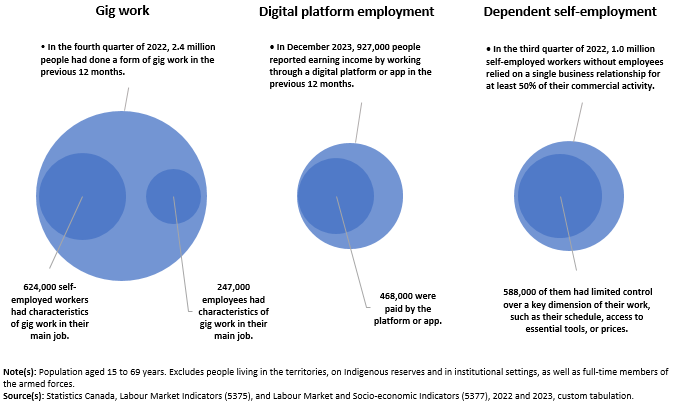Infographic 1
Estimates of the main components of the gig economy in 2022 and 2023

Infographic description
The title of the infographic is "Estimates of the main components of the gig economy in 2022 and 2023"
The infographic is composed of three large blue bubbles that are aligned horizontally. The size of each bubble reflects the number of people who completed gig work, digital platform employment and dependent self-employment. Smaller, darker blue bubbles are found within the larger bubbles to represent subcategories of the three phenomena.
The large bubble on the left is sized to represent 2.4 million people. The bubble is accompanied by the label, "In the fourth quarter of 2022, 2.4 million people had done a form of gig work in the previous 12 months."
Within the bubble representing gig work, there are two smaller bubbles. Starting from the left, the first one is sized to represent 624,000 people and is accompanied by the label, "624,000 self-employed workers had characteristics of gig work in their main job." The second bubble represents 247,000 people and has the label, "247,000 employees had characteristics of gig work in their main job."
The large middle bubble is sized to represent 927,000 people, with the label, "In December 2023, 927,000 people reported earning income by working through a digital platform or app in the previous 12 months."
Within the middle bubble is a smaller bubble, with the label, "468,000 people were paid by the platform or app."
The large bubble on the right is sized to represent 1.0 million people, with the label, "In the third quarter of 2022, 1.0 million self-employed workers without employees relied on a single business relationship for at least 50% of their commercial activity."
Within the large bubble is a smaller bubble, with the label, "588,000 of them had limited control over a key dimension of their work, such as their schedule, access to essential tools, or prices."
Note(s): Population aged 15 to 69 years. Excludes people living in the territories, on Indigenous reserves and in institutional settings, as well as full-time members of the armed forces.
Source(s): Labour Market Indicators (5375), and Labour Market and Socio-economic Indicators (5377), 2022 and 2023, custom tabulation.
- Date modified: